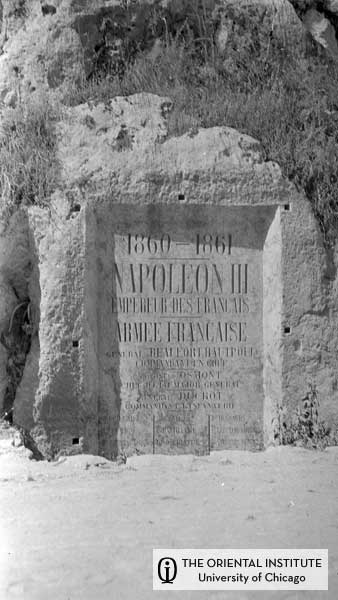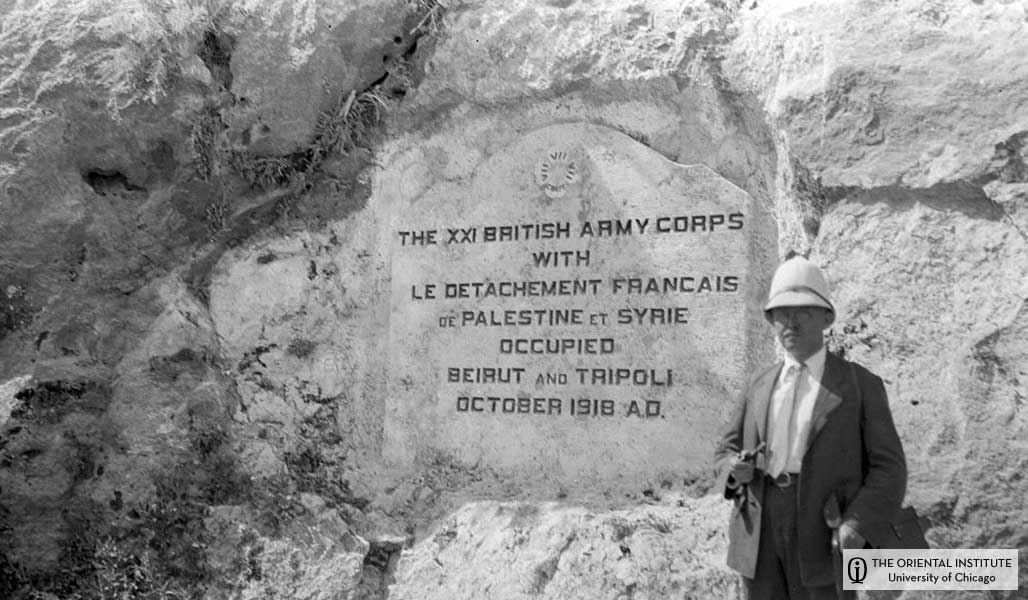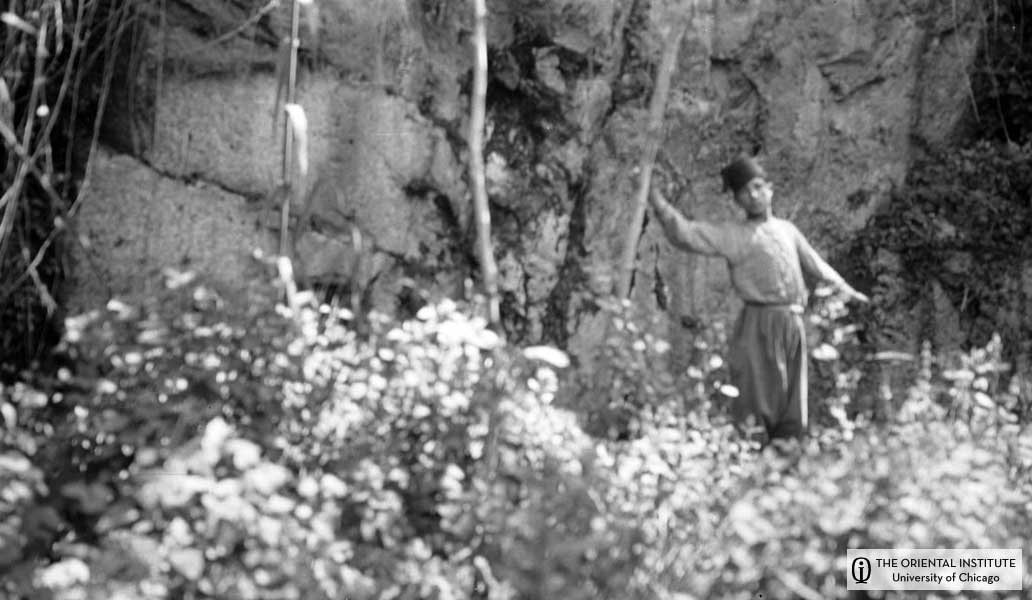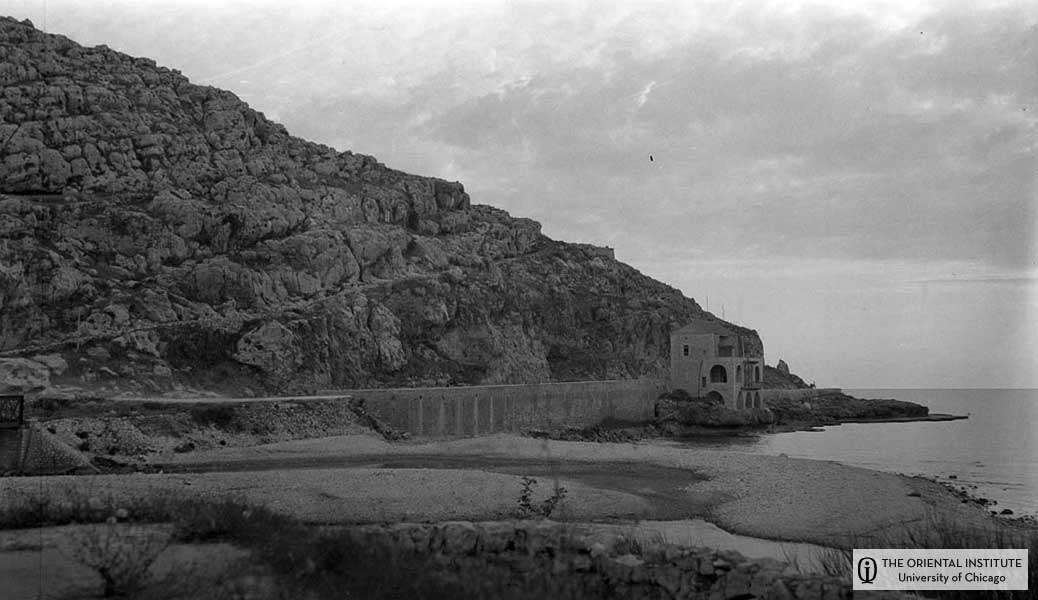Harold Nelson's House, Beyrut, Syria
May 23, 1920
Much of this letter is of course confidential. You may of course read it to President Jusdon. The Palestine situation will interest J. M. P. Smith.
My dear Frances —
I wired at once to Cairo to forward all mail here, but sufficient time has not yet elapsed to receive any. As I had a good letter from you at Aleppo, however, I have not been so long without home news as if the Baghdad letters had been the last. I sent you by registered post the day of my arrival (that is early last Tuesday morning, May 18), a journal letter containing almost the entire journey from Baghdad to Beyrut. I hope it may arrive in safety, for I was unable to make a carbon copy, and it is the only record I have, of what was really a remarkable journey, under the circumstances.
The trip from Baalbek here was uneventful, though it might have been otherwise, for after an hour’s ride south from Baalbek on the main line from Aleppo, we got out at Rayak, a junction where a rack and pinion road branches off and crosses the range of Lebanon to Beyrut. It is narrow gauge, and this section of the journey therefore demanded a change of cars. Our cumbrous equipment of camp furniture made the start and change as usual slow and laborious, but by six in the evening we were safely installed in the Rayak-Beyrut train, outfit and all. The trip over Lebanon is one of superb scenery, but darkness rapidly gathered and we were deprived of the magnificent prospects granted the traveler by day. The journey is one of about 40 miles from Rayak to Beyrut, but it takes from six to seven hours. We were due just before midnight, but it was nearly one o’clock before we pulled in at Beyrut Port station. Harold Nelson was down to meet us with a baggage cart and two carriages, and the outfit delayed us so long that it was about two A.M. when we reached his house. Mrs. Nelson had some hot chocolate for Harold and me, as we had dropped Luckenbill and the boys at the college, where they were given comfortable rooms in the new “Reynolds Club” (for I have forgotten its name) building. It was practically three o’clock when we turned in, for of course we had to give some account of ourselves after the remarkable journey through the desert.
I live most comfortably here in the guest room of the Nelson home, and Luckenbill comes down from the college for his meals here. Harold is most kind, as is his wife likewise. The college has given him complete freedom from all teaching and other duties so that he can go about with us. It is a great gratification to find a student of mine who has made good as decisively as Nelson has done. He is recognized as one of the leading members of the faculty, and he has a wide influence. I will make no effort to tell you of the institution, but it is a center of power and influence of which America may well be proud, and Nelson is contributing essentially to its influence and success. The graduates among the native Syrians are scattered all over the Near East. Two of them are in Feisal’s cabinet at Damascus, and the college has to be careful lest it should be compromised by the political activities of its former students who are now of course ardent nationalists loudly demanding independence.
We have now safely returned from our trip northward up the coast. I hired two automobiles (Fords of course) for two days. Harold went with us, and gave us exceedingly valuable information of all kinds. We stopped first a few miles north at the mouth of the Nahr el-Kelb (“Dog River”), where I had my first opportunity to see the remarkable records grouped there, — records which I have known for years, but have never been able to see. There are three great tablets of Ramses II, from the 13th century B.C., three carved by the Assyrians, presumably in the 7th century B.C., one huge record by Nebuchadnezzar (6th century B.C.), and several by the Romans, including a fine tablet of Marcus Aurelius. One of Ramses’ tablets has been usurped by the French and now contains a record of Napoleon III’s invasion. Beside it are two new tablets, one English and one Anglo-French, recording the latest invasions which have swept by this historic point. The records here looking out upon the sea and the wreckage of the ancient roads thus stretch from the 13th century B.C. to the 20th century A.D., a period of some 3300 years.
 Nahr el-Kelb: Inscription of Ramses dedicated to Ptah, re-used by the French expedition, 1860-61 for an inscription. May 23, 1920. (N. 3308, P. 6868)
Nahr el-Kelb: Inscription of Ramses dedicated to Ptah, re-used by the French expedition, 1860-61 for an inscription. May 23, 1920. (N. 3308, P. 6868)
 Nahr el-Kelb: Dog river inscriptions. Those at the left commemorate victories of the Egyptians and French and those at the right victories of the Assyrians and English. May 23, 1920. (N. 3309, P. 6869)
Nahr el-Kelb: Dog river inscriptions. Those at the left commemorate victories of the Egyptians and French and those at the right victories of the Assyrians and English. May 23, 1920. (N. 3309, P. 6869)
 Nahr el-Kelb: Inscription commemorating the occupation of Beirut and Tripoli by the English and French in 1918. D. H. H. Nelson is in the foreground. May 23, 1920. (N. 3310, P. 6870)
Nahr el-Kelb: Inscription commemorating the occupation of Beirut and Tripoli by the English and French in 1918. D. H. H. Nelson is in the foreground. May 23, 1920. (N. 3310, P. 6870)
 Nahr el-Kelb: Inscription of Nebuchadnezzar. May 23, 1920. (N. 3344, P. 6904)
Nahr el-Kelb: Inscription of Nebuchadnezzar. May 23, 1920. (N. 3344, P. 6904)
We stopped also to visit the old Scandinavian engineer of the Beyrut water works, Rudolph von Heidenstam, a very intelligent man of many languages, who has for some time been collecting the evidences of prehistoric man in this region. He has a fine collection of flint implements, both palaeolithic and neolithic, which he himself has found and studied with good results. I am going out to see him again, and if possible to spend a day with him among the places where he has been finding his flints. Much to my regret we did not find any traces of prehistoric man on the upper Euphrates. Indeed we were too much hurried and too much preoccupied by the possibilities of the immediate situation to search the river terraces as I would have been very glad indeed to do.
Leaving the old Swedish engineer we went on to Jebail or Gebail, the ancient Byblos, the oldest city on the Mediterranean, of which we have any knowledge. The Egyptians brought cedar from this port in the 30th century B.C. Nothing of the city of this oldest period can be discerned, but I went over the water front with some care, photographed the present harbor and what may have been an earlier one on the south, and found that the sea is cutting into the ancient mound along the water front. The early rubbish fills the hollows between promontories of projecting rock, and covers the rocks neighboring on the water with a mantle of ancient remains, — not of buildings, but of the small, loose wreckage of an ancient city such as we orientalists become very familiar with as we go about the Near East. If there are any remains of large buildings they are further inland, and are probably covered by the modern town.
On reaching Tripoli, which is some 53 miles from Beirut, we went to the house of Mr. Fowler, the resident missionary, who had made arrangements for putting us up. I wanted very much to get out north of Tripoli far enough to see around the north end of Lebanon, into the country behind it, or east of it, where we had so recently visited Kadesh as we came south from Aleppo. So Mr. Fowler drove out with us for an hour along the sea road north of Tripoli, and I got a snap shot of the pass leading from Kadesh to the sea, taken from the sea road. It was seven P.M. when we returned to the Fowler home, where Harold and I were put up, the others going to other quarters. Harold and I had to sleep together, and as the mosquitoes were very bad, we did not get much sleep.
Next morning we visited the old Crusaders’ castle overlooking the town, and had a look at the bazaars of Tripoli. It was ten o’clock when we finally started south again very reluctantly but it was quite impossible to go any further north, for we had gone the night before almost to the Nahr el-Kebir (the Great River = the ancient Eleutheros). Mr. Fowler figured that we had gone some 20 miles north of Tripoli, which would have carried us about 75 miles north of Beyrut. It was a most instructive glimpse of the Phoenician coast. I was greatly interested in the roads leading inland from the sea over Lebanon. The only one north of Beyrut until the end of Lebanon is reached, which is practicable for an army, is that of the Nahr Ibrahim, near Jebail, — a river of some volume, along which a road ascends into the mountains and reaches the valley between the two Lebanons. I walked up this valley for half a mile or more from the sea, and photographed the road for some distance up into Lebanon, finding the ruins of a fine old Roman bridge around the uppermost bend. It is the beautiful Adonis Vale of antiquity.
 Nahr el-Kelb: View looking south to inscriptions and showing new road and bridge. May 23, 1920. (N. 3356, P. 6916)
Nahr el-Kelb: View looking south to inscriptions and showing new road and bridge. May 23, 1920. (N. 3356, P. 6916)
Having this gained some very valuable notes on the topography and roads of the northern half of Phoenicia, we are beginning tomorrow with the southern half, including Tyre and Sidon. Old Dr. Ford, an American missionary, is still living at Sidon, but Tyre has been very unsafe. About a week ago the French governor of Sidon, with an armored car preceding and following him, was fired upon and some of his people wounded. Murder and robbery have been every day occurrences on this road for months. Several days ago the French bombed from the air and blew up the village of the bandits, and hanged a number of them at Tyre. The French commandant at Sidon (M. Charpentier) has been told by wire of our coming tomorrow and will be on the lookout for us. If it is safe for us to go on to Tyre, he will of course know all about it and can advise us what to do.
The programme has now become very simple and easy. This South Phoenician trip will occupy two days. Two or three more days in Beyrut will enable me to leave for Damascus, where I shall not remain more than two or three days. We learn that the Damascus-Haifa railroad is now running again, and we shall run over from Damascus to Haifa in a few hours, spending the next day on the battlefield of Megiddo, which is only an hour’s auto drive from Haifa. The next day I shall take the train for Jerusalem, arriving there presumably about a week from tomorrow, that is May 31. A fortnight in Jerusalem, running out to special points, is ample for all I want to do in Palestine, so that before the 15th of June I should be in Cairo again, as it is now only a night’s run by railway from Cairo. At present I am trying to secure a berth on a steamer for Naples leaving Alexandria, June 27th and arriving in Naples June 30th. I hope to sail from Naples by the Italian Line sometime between the 5th and the 15th of July. I should be in New York by August first, or even earlier. You may receive a cable before you read this giving you exact date of sailing from Naples.
This year I think we all deserve a good vacation in August, and I wish you would arrange for it, as soon as you receive this letter. If you think Fish Creek or one of the western simple country places too crude or inconvenient, I wish you would get the addresses from Mrs. Burton and write to Lake Placid in the Adirondacks and find out terms. You and the children could come east and get settled there, and I could come directly from the ship in three or four hours. If you could find someone to stay with the children you and Charles could come down the Hudson and meet me with the car, and we could drive up from New York to Lake Placid again. It would be simpler by train however, and we would have plenty of driving later. Ask Mr. David Jamieson, who you remember, has a country place up the Hudson; — maybe he could make a suggestion. He must know pleasant and inexpensive places up in that country.
Now another matter! I have been doing “a heap o’ thinkin’” since I received your account of Josie’s gradual failure. In Basrah the local missionary, Mr. Van Ess, was very helpful in finding us a cook. He is the Ali I have spoken of so often in my letters. He had been a cook in a restaurant for some time. It was of course an oriental restaurant, and quite different in cooking from ours. Ali said he had not seen his family for ten years. They lived in Mosul and as we were going to Mosul he would like to go with us. In Mosul he found that his father, his father’s brother, several of his brothers and sisters and his mother also I believe, had all died as a result of privation during the war. I expected he would want to leave us and stay in Mosul, but he only came to me and asked me for 50 rupees for his surviving sister, which I gave him. Since then he has stuck to us through thick and thin. Every night he has come around to see if my field bed was in order, and whether I needed my moustequaire put up. When he found we were headed for Aleppo and Egypt he announced he was going with us to Egypt. Recently I gave him what he thought was 50 piasters for food. It was really five notes of which four were tens and one was a fifty. Next day he brought back the fifty and said to me, “You gave me ninety, not fifty”. I thought this was pretty good…
This morning I asked him if he would like to go to America with me, and he at once responded that he would. I talked over pay with him, and I find he would be contented with his food and lodging which he doesn’t get now, and $25 or $30 a month. He has no friends, — nothing to keep him here, and what is more, if he stays within the borders of the Arab State he will be conscripted at once as a soldier. They tried to get him all the way down from Aleppo, but I had secured a police pass for him, and they could not touch him. Now he is in French jurisdiction and has no desire to put himself in the power of the Arabs again. He is 21 years old, small and boyish, — pathetically quiet and wistful… It will take $150 to $200 to get him to America, and after seeing the lad throughout a very trying campaign in Western Asia, I am ready to venture to take him to America to help you in the house…
For the full story of my exciting trip you should come to the special exhibit “Pioneers to the Past: American Archaeologists in the Middle East, 1919-1920,” at the Oriental Institute!
1155 East 58th Street Chicago, IL 60637
Hours:
- Tuesday 10:00 am to 6:00 pm
- Wednesday 10:00 am to 8:30 pm
- Thursday 10:00 am to 6:00 pm
- Friday 10:00 am to 6:00 pm
- Saturday 10:00 am to 6:00 pm
- Sunday noon to 6:00 pm
- Closed Mondays
http://oi.uchicago.edu/museum/special/pioneer/
And visit me on facebook at: http://www.facebook.com/profile.php?id=3318774#/profile.php?v=info&ref=profile&id=100000555713577